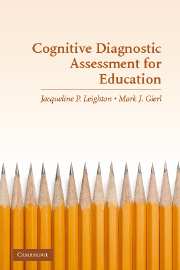Book contents
- Frontmatter
- Contents
- List of Contributors
- PART I THE BASIS OF COGNITIVE DIAGNOSTIC ASSESSMENT
- 1 Why Cognitive Diagnostic Assessment?
- 2 The Demand for Cognitive Diagnostic Assessment
- 3 Cognitive Modeling of Performance on Diagnostic Achievement Tests: A Philosophical Analysis and Justification
- 4 Test Validity in Cognitive Assessment
- PART II PRINCIPLES OF TEST DESIGN AND ANALYSIS
- PART III PSYCHOMETRIC PROCEDURES AND APPLICATIONS
- Author Index
- Subject Index
- References
3 - Cognitive Modeling of Performance on Diagnostic Achievement Tests: A Philosophical Analysis and Justification
Published online by Cambridge University Press: 23 November 2009
- Frontmatter
- Contents
- List of Contributors
- PART I THE BASIS OF COGNITIVE DIAGNOSTIC ASSESSMENT
- 1 Why Cognitive Diagnostic Assessment?
- 2 The Demand for Cognitive Diagnostic Assessment
- 3 Cognitive Modeling of Performance on Diagnostic Achievement Tests: A Philosophical Analysis and Justification
- 4 Test Validity in Cognitive Assessment
- PART II PRINCIPLES OF TEST DESIGN AND ANALYSIS
- PART III PSYCHOMETRIC PROCEDURES AND APPLICATIONS
- Author Index
- Subject Index
- References
Summary
To interpret and use achievement test scores for cognitive diagnostic assessment, an explanation of student performance is required. If performance is to be explained, then reference must be made to its causes in terms of students' understanding. Cognitive models are suited, at least in part, to providing such explanations. In the broadest sense, cognitive models should explain achievement test performance by providing insight into whether it is students' understanding (or lack of it) or something else that is the primary cause of their performance. Nevertheless, cognitive models are, in principle, incomplete explanations of achievement test performance. In addition to cognitive models, normative models are required to distinguish achievement from lack of it.
The foregoing paragraph sets the stage for this chapter by making a series of claims for which we provide philosophical analysis and justification. First, we describe the philosophical standpoint from which the desire arises for explanations of student test performance in terms of causes. In doing this, we trace the long-held stance within the testing movement that is contrary to this desire and argue that it has serious weaknesses. Second, we address the difficult connection between understanding and causation. Understanding as a causal factor in human behavior presents a metaphysical puzzle: How is it possible for understanding to cause something else to occur? It is also a puzzle how understanding can be caused. We argue that understanding, indeed, can cause and be caused, although our analysis and argument are seriously compressed for this chapter.
- Type
- Chapter
- Information
- Cognitive Diagnostic Assessment for EducationTheory and Applications, pp. 61 - 84Publisher: Cambridge University PressPrint publication year: 2007
References
- 6
- Cited by



